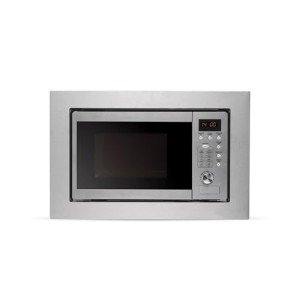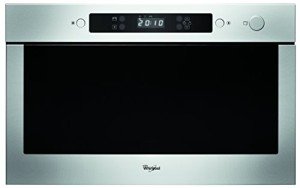What's The Current Job Market For Small Built In Microwave Professiona…
페이지 정보

본문
 How to Choose a Small Built in Microwave Oven
How to Choose a Small Built in Microwave OvenSave counter space and reclaim work surface area by relocating your microwave into a recessed space in the cabinetry or wall. Built-in microwaves are a great option for kitchens of all sizes. They seamlessly blend into the cabinetry or wall.
This 1.2-cubic-foot oven has 10 power settings and presets for popular food items like pizza, popcorn and frozen veggies. It also has a sensor that calculates the cooking time based upon food weight and density.
Power
A small built in microwave oven is a fantastic kitchen appliance for cooking or warming meals. These appliances are usually powerful and can heat food quickly and evenly. The key is to find the right microwave oven for your needs. Some features to consider include size and design, power level, and the control options. Certain models have large icons to help you select the correct settings, while others feature smooth controls that are easy to read in different lighting conditions. The number of racks and the type of turntable you choose are crucial aspects to take into consideration.
When choosing a micro that is small it is crucial to think about the machine's interior capacity. The typical countertop microwave measures 1.2 to 2 cubic feet in size. A larger microwave can cook more food at one time, however it could take longer to heat. You should also check the dimensions on the outside to ensure that it fits in the space you want it to.
There are three types of microwave ovens: conventional, convection and oven. Conventional microwaves heat food using electromagnetic radiation. They are ideal for standard uses for reheating leftovers and defrosting foods. Convection microwaves can be used to roast or bake food. They usually have a heating element and an air-flow fan that circulates hot air around it. Additionally, an oven microwave combines the functions of a conventional and convection microwave into one unit.
It is not enough to be aware of the power, but also to the maximum and minimum power of your microwave. The minimum power level for a microwave oven is 800 watts, and the maximum is 1,200 watts. If you're buying a new microwave, you should avoid buying a model that has less than 1,000 watts because it will not cook your food properly.
Installing a built-in microwave in your cabinetry is a great option to reduce space. This will help you save counter space and make your home look more elegant. You can even get trim kits to make your microwave look like it's part of your cabinets. These options are more costly than countertop microwaves and over the range models, but easier to use and can give your home a a high-end appearance.
Convenience
A small built in microwave oven is a handy method to heat drinks and food. It helps to save space on countertops and allows room for meal prep. It is essential to choose one that has the features you need. Many models include racks and a turntable, and other kitchen accessories to make cooking easier. Some models also have a crisper pan that mimics traditional oven baking, bringing crisp texture to food items.
Microwaves come in various sizes and finishes to suit the design of your kitchen. Certain models come with recessed doors that blend into the cabinetry to give it a custom appearance. To select the ideal place for your microwave, it's important to consider how often you'll use it and who will use it. Additionally, you'll need ensure that there's enough space for ventilation in accordance with the manufacturer's instructions.
Above the refrigerator, there is a popular place to store a microwave. This keeps the microwave from being a mess and makes it easier to reach. It can be dangerous to children or those with shorter legs, and you will need to remove and store the Microwave Oven Built-in each time you use it.
Another option is to place the microwave in an extra cabinet. This is a great option for those with a limited counter space. It also gives an elegant and subtle appearance. It's also a good option for those who don't want to invest in an appliance drawer, but need a convenient place to cook food and beverages.
You can also add shelves that pull out to the pantry designed to fit a microwave oven grill integrated. These shelves are large enough to fit into any space, and deep enough to prevent them from tipping. Some options even have a curved edge that helps stop spills and tipping.
Another option is stacking the microwave on top of an oven that is a match in a cabinet that is mid-height. This is a traditional setup and is ideal for Transitional style kitchens. Most manufacturers offer trim kits to ensure that the microwave aligns with the oven's depth. These kits are available in louvered and flat designs and can be installed proud of the millwork or flush mounted.
Design
 It's important to choose an aesthetic that incorporates the white built in microwave-in microwave into the kitchen design. Its large footprint on the countertop can detract from the appearance of your kitchen. Luckily, there are many ways to conceal this small appliance, without having to sacrifice countertop space or storage.
It's important to choose an aesthetic that incorporates the white built in microwave-in microwave into the kitchen design. Its large footprint on the countertop can detract from the appearance of your kitchen. Luckily, there are many ways to conceal this small appliance, without having to sacrifice countertop space or storage.Another option is to put in cabinets or an appliance garage to conceal the microwave when not being used. This is particularly useful for small kitchens with limited wall space. This type of cabinet is adjustable to be in line with the trim and door style in your kitchen, giving it a a sleek custom appearance.
You can also hide your microwave by incorporating it into the cabinetry of your pantry. This gives it a clean, uncluttered look while keeping it easily accessible. This kind of arrangement is perfect for a smaller kitchen, and can be paired with other pantry cabinets to maximize storage space.
Certain microwaves have built-in racks or turntables that let you to cook a variety of dishes at the same time. These features can make it more efficient as well as efficient. However, it's important to use microwave-safe cooking utensils and cookware when using these appliances. Avoid cooking and cookware made of metal or with metallic accents, since they can spark and damage the microwave.
Microwaves that are designed to be installed inside drawers or cabinets can feature venting systems that are compatible with these enclosed spaces. It is important to talk to your contractor to ensure that proper venting is specified. A microwave should not be placed in front of windows, since it could block them and prevent ventilation.
You can also incorporate a microwave into your kitchen design by mounting it on a counter or tucking it away on an island. The drawer-style microwave is an ideal option for kitchens with small counter space. It is easily accessible by users of any height.
Another option is to place the microwave on top of a built-in wall oven. This type of installation is suitable for Transitional or Traditional Kitchens. To complete the installation, Kitchen Designers can utilize a trim kit to cover any gaps around the unit. These kits are available in louvered and flat styles and can be used in conjunction with your oven.
Cost
A small built in microwave oven can be a stylish kitchen upgrade, adding both aesthetics and functionality to your kitchen's design. Choose from a variety of designs and finishes to match your decor and look for features like automatic defrost cooking settings, cook settings, and timers that will make meal preparation simpler. Some microwaves also have designs that help them resist fingerprints, which means you can keep them clean.
While microwaves on the countertop are simple to use, they take up valuable counter space and can limit your kitchen's functionality and design options. If you're worried about this, consider an recessed model that could be installed within your cabinetry to create an elegant, customized look. Installing a small, built-in microwave oven in your kitchen island can provide more space and an attractive integrated appearance. It's important to keep in mind that a microwave with a recess needs adequate air clearance around its rear and sides to function correctly.
When determining where to place your microwave, think about how often you'll make use of it and the type of food you typically cook. If you typically cook frozen meals and pizzas select a model with more power that will cook food quickly and evenly. If you're cooking vegetables or foods that need a more delicate heat, choose an appliance with lower watts to avoid overcooking.
Install a mobile, small stand if it's not possible to fit the microwave into a cabinet or prefer a smaller. They are designed with a base designed to hold the microwave in place, and keep it up straight and usually feature a non-smudge surface. These stands are a handy and inexpensive option that can be used to keep your microwave in storage until you find the right place for it in the kitchen.
Another alternative is to install an oven-sized microwave to the corner of your kitchen, and it could be used as a mini-hood for your stove. This is a great way to reduce space, but it's not recommended for homes with children or elderly residents that need easy access to their kitchen. A corner microwave should not be placed on top of a window since it may block airflow and break the glass in the case in the event of an emergency.
- 이전글The 9 Things Your Parents Taught You About Leather Couch With Chaise 24.11.26
- 다음글The Aviator Gaming Revolution: From AC Milan Partnership to Legal Battles and Mobile Strategy Guide 24.11.26
댓글목록
등록된 댓글이 없습니다.

